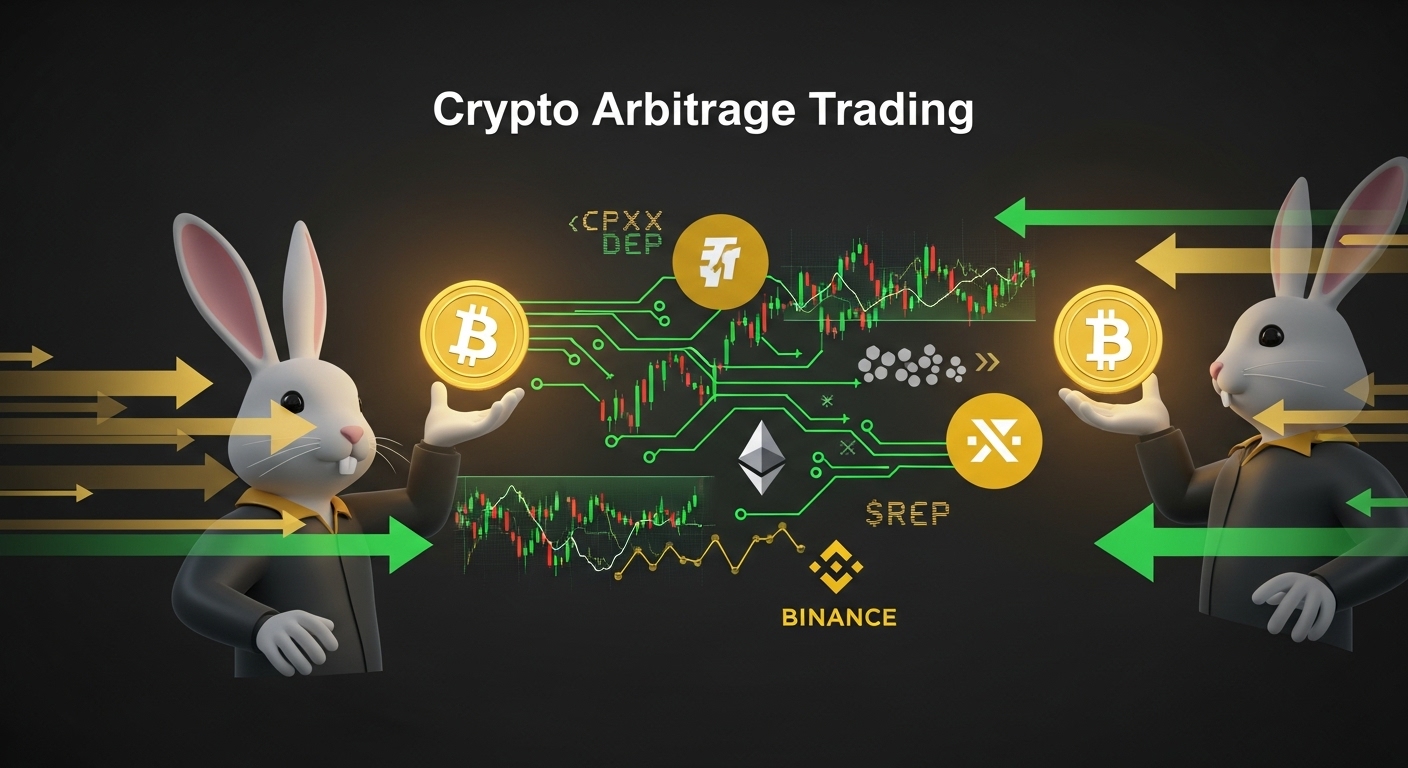Crypto arbitrage trading is all about spotting price differences for the same cryptocurrency across different exchanges, then buying low on one platform and selling high on another.
Traders look for these gaps because crypto prices don’t always line up perfectly, creating opportunities to make small but quick profits.
This post will walk you through the basics of how crypto arbitrage works, the tools you need to spot these opportunities, and the main risks to watch out for.
If you’re new to the concept, you’ll get a clear picture of what’s involved and what to consider before jumping in.
How Arbitrage Works in Crypto Markets

Understanding how arbitrage functions in crypto markets means grasping the different methods traders use to find price gaps and the key reasons these gaps appear.
Arbitrage is about spotting and acting on those small differences before they vanish. The crypto world offers unique setups for arbitrage that don’t always exist in traditional finance.
Let’s break down the major types of crypto arbitrage and the factors that open or close these opportunities. Before then, check out this article on Is Trading Crypto Worth It? (Complete Guide for Beginners).
Types of Crypto Arbitrage
There are a few common types of arbitrage traders rely on to profit from price differences:
• Spatial Arbitrage
This happens when a cryptocurrency is cheaper on one exchange than another, like buying Bitcoin on Exchange A for $20,000 and selling it on Exchange B for $20,100.
• Triangular Arbitrage
This involves trading between three different cryptocurrencies on a single exchange to exploit price differences, for example swapping BTC to ETH, then ETH to USDT, and finally USDT back to BTC when price ratios are out of sync.
• Statistical Arbitrage
A more complex strategy using algorithms to identify patterns and price deviations over time, betting the price will revert to a historical average.
Each type appeals to different skill levels and tools but the core idea remains the same: buy low and sell high by spotting quick profit windows.
Key Factors That Create Arbitrage Opportunities
Price gaps between exchanges or pairs don’t happen randomly. Several factors affect whether arbitrage chances are wide open or nearly non-existent:
• Exchange Liquidity
High liquidity means lots of buyers and sellers, which usually tightens prices and shrinks arbitrage gaps. Low liquidity lets prices vary more, creating larger spreads to exploit.
• Fee Structures
Trading fees, deposit or withdrawal costs can eat into profits or completely wipe them out. If one exchange charges higher fees, it might widen the price difference, but the net gain might be smaller.
• Withdrawal Limits
Exchanges with strict or slow withdrawal limits can reduce the ability to quickly move funds, slowing down arbitrage trades and making price gaps risky to chase.
• Network Congestion
When blockchain networks slow down or get congested, transaction times and costs rise. This delays trade execution and forces traders to factor in higher expenses, which shrinks profits or widens risks.
Knowing these factors helps traders decide when arbitrage is worth chasing and when it’s better to sit it out. The market’s constant shifts in liquidity, fees, and blockchain speed make arbitrage a dynamic challenge that needs fast decisions.
This section ties into the overall process of spotting and managing arbitrage in crypto, showing you the building blocks behind why these opportunities appear in the first place.
For more on how to spot the best trades, check out other practical guides on crypto trading techniques.
Tools and Platforms for Executing Arbitrage

When it comes to crypto arbitrage trading, having the right tools and platforms at your fingertips can make the difference between a smooth profitable trade and a missed opportunity.
Choosing where you buy and sell, along with how you execute your trades, sets the foundation for your strategy’s success. Let’s explore key aspects you should consider to build a reliable arbitrage setup.
Choosing the Right Exchange
Not all exchanges are built the same, especially when your goal is to act quickly on price differences. Here are some key criteria to prioritize:
• Low Fees: Every trade eats into your profit. Look for exchanges with low trading fees, and also consider withdrawal fees. Even small percentages can add up when you’re moving funds frequently.
• Fast Withdrawals: Speed matters. If withdrawing your crypto takes hours or days, you risk losing the price gap before you complete your trade. Exchanges offering quick and reliable withdrawals help you move assets faster.
• Reliable API: If you plan to automate trading or track prices in real time, a stable API is crucial. It ensures your tools and bots can interact with the exchange without downtime or errors.
• Supported Trading Pairs: Your arbitrage strategy depends on matching pairs available on both exchanges. Check to confirm the same pairs are actively traded to avoid awkward delays or extra currency conversions.
Exchanges like Binance, Kraken, and Coinbase Pro often meet these requirements, but always verify updated fee schedules and withdrawal policies.
Balancing these factors helps you pick platforms that won’t slow down your arbitrage moves. You want to explore more Trading opportunities? See this article, Does Crypto Trade Like Stocks? (Ultimate Guide for Beginners).
Automated Bots vs Manual Trading
Once you have your exchanges nailed down, the next big decision is whether to use automated bots or trade manually.
• Automated Bots
Bots work tirelessly and instantly react to price gaps across dozens of exchanges. Their speed beats even the fastest human trader. Bots also handle complex strategies like triangular arbitrage without missing a beat.
However, bots come with some risks.
If set up incorrectly, they might execute trades that lose money or get stuck due to API failures or network issues. They also require initial setup time, regular maintenance, and careful monitoring to avoid costly mistakes.
• Manual Trading
Trading manually offers you full control. You can react to market conditions, exercise discretion in unexpected scenarios, and avoid bot glitches. This approach suits beginners or those testing arbitrage with limited funds.
The downside is slower reaction time. Price gaps can disappear in seconds, and manual trades may lag by minutes. Complex strategies also get tricky without automation.
In many cases, traders start manually to understand the market and then shift gradually to bots. Combining both gives you flexibility: bots handle routine trades fast, and you step in when judgment calls are needed.
Choosing between bots and manual methods depends on your skill level, time availability, and appetite for risk. Tools for automated trading continue to improve, but there is still value in staying hands-on until you trust the tech.
By picking the right exchanges and deciding how to execute trades, you set yourself up for smarter, faster arbitrage.
These choices shape your entire trading experience, from spotting chances to locking in profits efficiently. We have some suggestion for you. Top 10 AI Tools for Crypto Arbitrage Trading.
Risk Management and Common Pitfalls

Successful crypto arbitrage isn’t just about spotting price gaps; it’s about managing all the costs and risks that can turn a promising trade into a loss.
When dealing with fast moves across exchanges, overlooking fees or ignoring market conditions can wipe out profits or lead to unexpected setbacks. This section covers the key areas where traders often stumble and how to avoid those traps.
Fee Calculations
Fees can silently eat into your arbitrage profits if you don’t factor them in from the start. In crypto trading, there are several types of fees to watch for: maker fees, taker fees, withdrawal fees, and network fees.
• Maker Fees apply when you add liquidity to the order book by placing limit orders. These are usually lower but depend on the exchange.
• Taker Fees kick in when you execute market orders or take liquidity by matching an existing order. These fees tend to be higher than maker fees.
• Withdrawal Fees come into play when moving your cryptocurrencies off the exchange. These are often fixed per asset and can be high on some platforms.
• Network Fees are blockchain transaction fees paid to miners or validators. These vary by asset and network congestion.
To get a true picture of your profit, add all these fees into your calculations. For example, if you buy Bitcoin on Exchange A and sell it on Exchange B, calculate:
Profit = (Sell price on Exchange B - Buy price on Exchange A) - (Maker/taker fees + Withdrawal fees + Network fees)
Ignoring these expenses can give a false sense of profit. Many traders undercut their gains by skipping withdrawal or network fees, especially on congested blockchains where fees spike unexpectedly.
Always check the fee schedule of your chosen exchanges and adjust your target profit margin accordingly.
Liquidity and Slippage
Liquidity affects how smoothly you can execute your trades. If the order book is thin or the market volume is low, your intended trade size might not fill at expected prices, leading to slippage, a difference between your expected price and the actual execution price.
Low liquidity means placing a large order can push the price up (if buying) or down (if selling), shrinking your arbitrage window or even turning profits into losses. This is especially common with altcoins or smaller exchanges.
To manage this risk:
• Check order book depth before placing trades. Focus on exchanges showing stable buy and sell walls at prices close to your intended trade.
• Adjust your trade size to fit within available liquidity without causing significant price movement.
• Consider splitting large trades into smaller chunks to minimize slippage but stay aware of increased fees and execution time.
Remember, no matter how attractive an arbitrage gap looks, if the market can’t handle your trade volume efficiently, the cost of slippage can eliminate your edge.
Keeping a realistic view on trade sizes and liquidity helps keep your strategy robust and reduces costly surprises. Get a look at this guide too, Risk Management In Crypto Trading.
By carefully factoring in fees and keeping an eye on liquidity and slippage, you can sharpen your approach and protect your earnings.
These are two of the most common pitfalls in arbitrage trading, but they are also fully within your control.
For more detailed tips on managing risks in crypto trading, check out CoinBuns’ comprehensive guides and reviews.
Regulatory and Tax Considerations
When you start crypto arbitrage trading, staying on top of regulatory and tax matters is just as important as spotting price gaps.
These areas can impact your profits and your legal standing. Understanding the rules and keeping clear records are essential steps that many traders overlook until it’s too late.
Keeping Accurate Transaction Logs
Tracking every trade should be part of your daily routine, not an afterthought. Arbitrage involves lots of quick trades across multiple exchanges, and without good logs, you risk losing track of your true profit or facing problems during tax time.
A spreadsheet is a simple yet powerful tool to start with. Key details to record include:
• Trade date and time (timestamp)
• Cryptocurrency bought and sold
• Amounts involved
• Buy and sell prices
• Fees for trading, withdrawals, and network costs
• Exchange names used for each transaction
For those looking for more automation, tools like CoinTracker, Koinly, or even Google Sheets with API integrations can simplify this process and reduce manual errors.
Whichever method you pick, consistency is key. Logs help you see patterns, calculate exact profits, and provide the paper trail needed for taxes or audits.
Understanding Local Tax Rules
Tax treatment on crypto arbitrage depends on where you live, but most countries classify profits from arbitrage as capital gains.
This means you owe tax on the difference between your buying and selling prices, after subtracting fees and other costs.
Tax rules can vary widely:
• Some places require you to report every trade.
• Others tax gains annually, depending on how long you held the asset.
• Certain countries might treat crypto as property, affecting how gains or losses are calculated.
Because tax laws around cryptocurrency are still developing, it’s wise to consult a tax professional familiar with crypto.
They can help you stay compliant, avoid costly mistakes, and sometimes even help reduce your tax burden through proper accounting strategies. Ignoring tax responsibilities might lead to penalties that undo your trading gains.
By maintaining solid transaction records and understanding your tax duties, you protect your arbitrage profits and trade with confidence. This groundwork is as important as the trading itself for long-term success.
Conclusion
Starting crypto arbitrage trading involves careful steps to protect your investment and maximize potential profits.
Begin with small amounts to test your strategy and understand how fees, liquidity, and timing affect your trades. Monitor risks continuously and adjust your approach as markets or exchange policies change.
Using the right exchanges and tools helps improve your chances of success while making your trading smoother.
Remember that patience and good record-keeping go a long way in building a sustainable arbitrage practice. Taking these precautions will set a solid foundation and keep you ready for new opportunities as they arise.

Adeyemi Adetilewa is a digital marketing strategist and writer with over a decade of experience helping B2B, SaaS, Web3, and eCommerce brands grow through data-driven marketing. Adeyemi empowers professionals and business owners with actionable insights, growth strategies, and digital tools for success.

